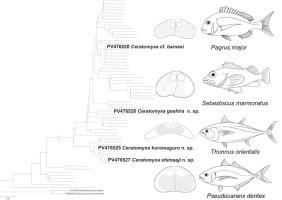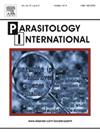寄生于日本海鱼的四种角蝇的形态和分子特征,包括三个新种的描述
IF 1.9
4区 医学
Q3 PARASITOLOGY
引用次数: 0
摘要
在日本西部进行的一项寄生虫学调查发现,在四种海洋鱼类的胆汁和胆囊中发现了黏液孢子寄生虫:养殖白鲹(Bloch & Schneider)、太平洋蓝鳍金枪鱼(Temminck & Schlegel)、红鲷(Temminck & Schlegel)和野生假海带(Sebastiscus marmoratus)。形态学鉴定和小亚基rDNA的分子分析证实这些寄生虫属于角鼻虫属。鉴定出3个新种,分别为:长齿姬角鼻虫(流行率100%,n = 8条)、东方江角鼻虫(流行率100%,n = 1条)、黑黑角鼻虫(流行率100%,n = 1条)和马氏江角鼻虫(流行率100%,n = 1条)。此外,在P. major鱼中检测到barnesi角鼻虫(发生率10%,n = 10)。虽然这些角鼻虫对宿主的病理作用仍有待进一步研究,但本研究有助于更广泛地了解角鼻虫在海洋鱼类中的多样性和地理分布。本文章由计算机程序翻译,如有差异,请以英文原文为准。

Morphological and molecular characterization of four Ceratomyxa species parasitizing marine fish in Japan including descriptions of three new species
A parasitological survey in western Japan identified the myxosporean parasites in the bile and gallbladders of four marine fish species: farmed white trevally Pseudocaranx dentex (Bloch & Schneider), Pacific bluefin tuna Thunnus orientalis (Temminck & Schlegel), and red seabream Pagrus major (Temminck & Schlegel), as well as wild false kelpfish Sebastiscus marmoratus (Cuvier). Morphological characterization and molecular analysis of the small subunit rDNA confirmed that these parasites belong to the genus Ceratomyxa. Three novel species were identified: Ceratomyxa shimaaji n. sp. from P. dentex (prevalence 100 %, n = 8 fish), Ceratomyxa kuromaguro n. sp. from T. orientalis (prevalence 100 %, n = 1 fish), and Ceratomyxa gashira n. sp. from S. marmoratus (prevalence 100 %, n = 1 fish). Additionally, Ceratomyxa cf. barnesi, was detected in P. major (prevalence 10 %, n = 10 fish). While the pathological effects of these Ceratomyxa species on their hosts remain to be investigated, this study contributes to a broader understanding of the diversity and geographic distribution of Ceratomyxa spp. in marine fish.
求助全文
通过发布文献求助,成功后即可免费获取论文全文。
去求助
来源期刊

Parasitology International
医学-寄生虫学
CiteScore
4.00
自引率
10.50%
发文量
140
审稿时长
61 days
期刊介绍:
Parasitology International provides a medium for rapid, carefully reviewed publications in the field of human and animal parasitology. Original papers, rapid communications, and original case reports from all geographical areas and covering all parasitological disciplines, including structure, immunology, cell biology, biochemistry, molecular biology, and systematics, may be submitted. Reviews on recent developments are invited regularly, but suggestions in this respect are welcome. Letters to the Editor commenting on any aspect of the Journal are also welcome.
 求助内容:
求助内容: 应助结果提醒方式:
应助结果提醒方式:


